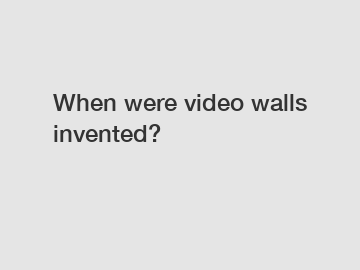Jan. 27, 2024
Consumer Electronics
When were video walls invented?
Video walls have become a common sight in today's modern world. From shopping malls to control rooms, these impressive displays have the ability to mesmerize viewers with their larger-than-life visuals. But have you ever wondered when video walls were first invented? Let's delve into the history and discover the origins of this groundbreaking innovation that has revolutionized the way we perceive visual media.
The Early Beginnings.

The concept of a video wall can be traced back to the early 1980s when the technology to merge multiple screens into a seamless display was first explored. The initial video walls consisted of hundreds of individual CRT (Cathode Ray Tube) monitors, each connected to a separate video source. These monitors were arranged in a matrix formation and required complex wiring and synchronization to create a unified picture.
Emergence of Rear Projection Video Walls.
As technology advanced, rear projection video walls emerged in the late 1990s. This development allowed for a significant reduction in the size and complexity of video walls. Rear projection video walls utilized multiple projectors to create a cohesive image, eliminating the need for hundreds of separate monitors. The projectors were positioned behind a screen to project the images onto it, resulting in a seamless video wall.
The Advent of LCD and LED Video Walls.
LED video walls, on the other hand, took video wall technology to a whole new level. LED displays are composed of small LED modules that emit light when an electric current passes through them. This technology allowed for even greater flexibility in video wall design, as the LED modules could be seamlessly arranged in any configuration, allowing for curved and custom-shaped video walls.
The Evolution of Video Wall Control Systems.
Alongside technological advancements in display technology, control systems for video walls have also evolved significantly over the years. Initially, video walls required manual configuration and adjustment to ensure proper synchronization. However, with the advent of sophisticated software and hardware solutions, video wall control became more user-friendly and efficient.
Modern video wall control systems offer a wide range of functionalities, such as remote management, real-time monitoring, and content distribution. These systems allow users to control every aspect of the video wall from a centralized location, streamlining the operation and maintenance process.
Conclusion.
Video walls have come a long way since their inception in the early 1980s. Starting from cumbersome matrix formations with CRT monitors to sleek and vibrant LCD and LED displays, the technology behind video walls has undergone significant transformations. Today, video walls have become an integral part of various industries, catering to diverse applications such as advertising, entertainment, surveillance, and presentations.
If you are interested in incorporating a video wall into your business or organization, it is advisable to consult with professionals who specialize in video wall installation and management. They can provide expert guidance and assist you in selecting the right technology for your specific requirements. Whether it's for a control room, corporate lobby, or retail environment, video walls can undoubtedly enhance visual communication and captivate your audience.
To learn more about video walls and explore the possibilities they offer, feel free to contact us. Our team of experts is ready to assist you in creating a visually stunning and impactful video wall experience.
For more 75 inch lcd video wall, 75 inch lcd video wall, led video wall manufacturerinformation, please contact us. We will provide professional answers.
Previous: Unlock Your Potential: Mastering the Fixed Focus
Next: What are the top 10 portable chargers for bulk purchase?
If you are interested in sending in a Guest Blogger Submission,welcome to write for us!
All Comments ( 0 )